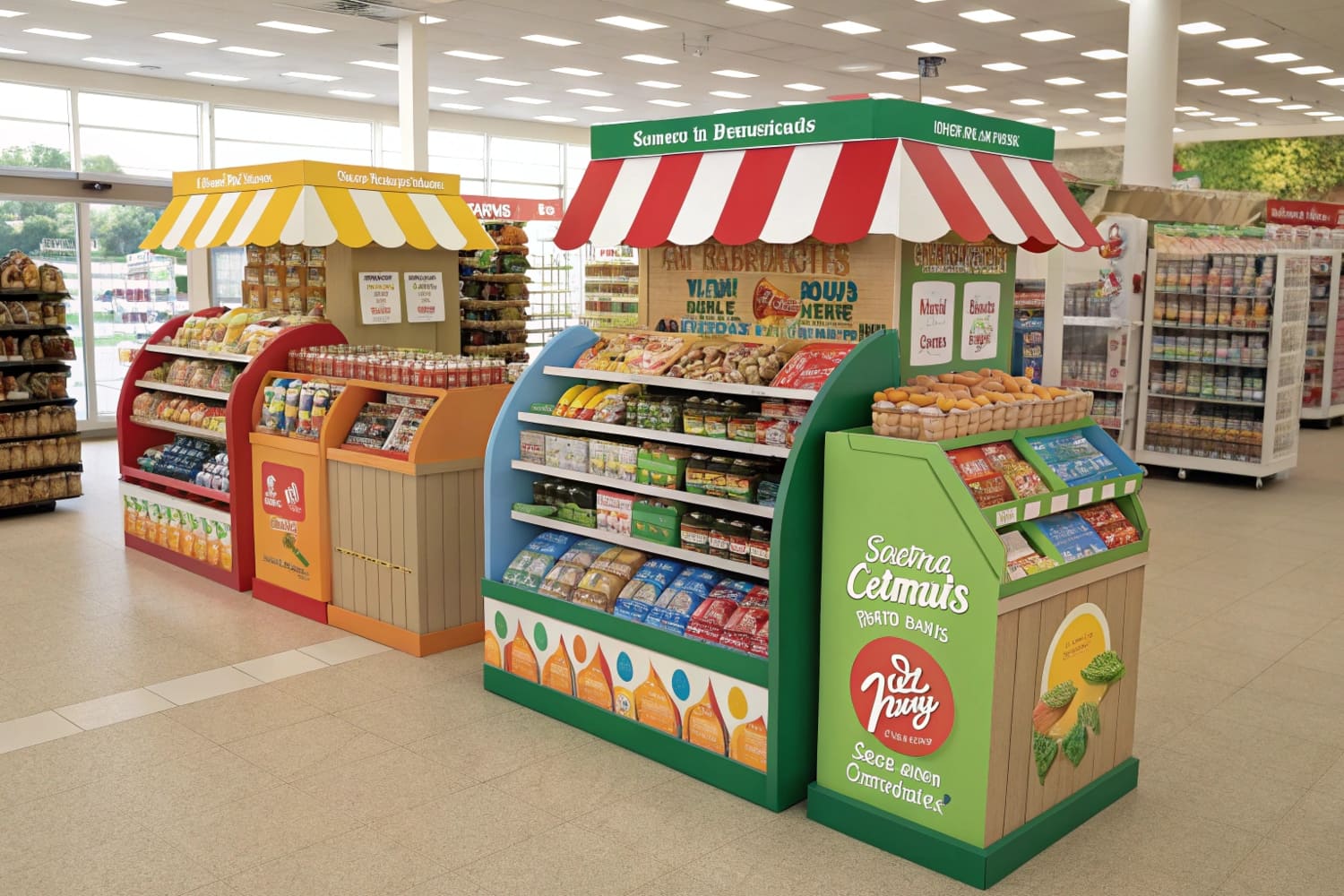De nombreux magasins semblent bondés, pourtant les ventes sont en deçà des objectifs. Les clients déambulent rapidement. Les présentoirs sont utiles, mais les équipes manquent de stratégie. J'utilise le merchandising visuel pour optimiser le parcours client.
Les marques, les détaillants et les agences de marketing utilisent le merchandising visuel en magasin, lors d'événements et en ligne pour attirer l'attention, susciter des achats impulsifs et raconter une histoire de marque claire grâce à des solutions d'affichage économiques, rapides et recyclables.
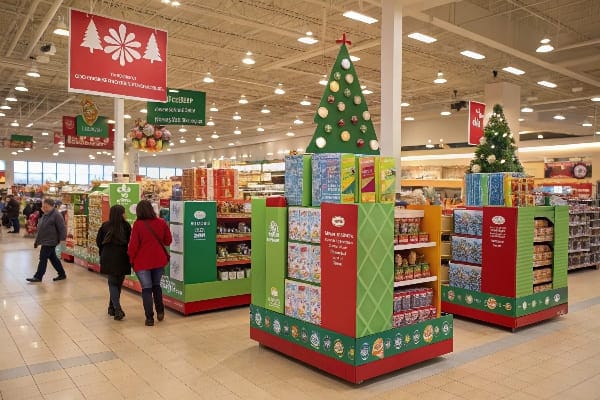
Je vous montrerai qui l'utilise, où il est le plus efficace, qui y participe et pourquoi il stimule les ventes. Mes conseils seront simples et pratiques, de l'atelier au rayon.
Où est utilisé le merchandising visuel?
Nombre d'équipes exposent leurs produits n'importe où en espérant des ventes. Les clients passent à côté de l'offre. L'espace est encombré. Je place les présentoirs là où le passage et l'intention d'achat se rencontrent. Un emplacement judicieux change rapidement la donne.
Le merchandising visuel est utilisé aux entrées des magasins à fort trafic, dans les allées principales, en bout de rayon, aux caisses, dans les zones de palettes des magasins-entrepôts, dans les boutiques éphémères, les salons professionnels et même sur les pages de commerce électronique, partout où l'attention est rare et le choix difficile.

Zones à conversion rapide
Je cartographie le parcours complet, de l'entrée à la caisse. Je sélectionne les zones à fort potentiel d'attraction . J'adapte le type de présentoir à la fonction. Dans les supermarchés, les présentoirs au sol incitent à la découverte. Sur les comptoirs, les petits présentoirs numériques encouragent l'essai. Dans les entrepôts-magasins, les présentoirs sur palettes mettent en valeur les produits en gros. Dans les pharmacies, les allées étroites nécessitent des plateaux compacts. Dans les chaînes de magasins d'articles de plein air, les présentoirs verticaux permettent de placer le matériel à hauteur des yeux. J'évite les zones inutilisées. Je suis des règles simples : hauteur des yeux, accessibilité, choix restreint. J'utilise des titres percutants, des textes courts et des couleurs claires. Je privilégie les présentoirs à plat pour réduire les frais de transport. Je conçois mes présentoirs avec du carton recyclable pour répondre aux exigences des acheteurs en Amérique du Nord et en Europe. En Asie-Pacifique, je prévois des rotations rapides car la réactivité saisonnière est essentielle.
| Lieu / Moment | Pourquoi ça marche | Affichage typique |
|---|---|---|
| entrée du magasin et allée principale3 | Forte fréquentation, amorçage précoce | Présentoir de sol, arche, présentoir |
| Capeur | Visibilité optimale, choix simple | Kit d'embout, plateaux d'étagères |
| Vérifier | Temps d'oisiveté, impulsion | PDQ de comptoir, bande de clips |
| Zone de palettes du club | Échelle, indice de valeur | Présentoir sur palette, quart de palette |
| Événement éphémère | L'histoire d'abord, le procès | Kiosque publicitaire, table de démonstration |
| PDP e-commerce4 | friction décisionnelle | Rendu 3D, image de style de vie, bloc de comparaison |
Qui fait le merchandising visuel?
Beaucoup d'entreprises pensent que c'est le travail d'une seule personne. Le rythme de travail ralentit. Les délais ne sont plus respectés. Je constitue une petite équipe soudée pour que les idées soient livrées à temps et conformément au cahier des charges.
Les responsables du merchandising en magasin, les équipes commerciales des marques, les spécialistes du marketing en point de vente, les designers et les fabricants de présentoirs spécialisés planifient et exécutent le merchandising visuel ; les petites entreprises font appel à des agences ou à des usines à service complet pour concevoir, prototyper, tester et produire.
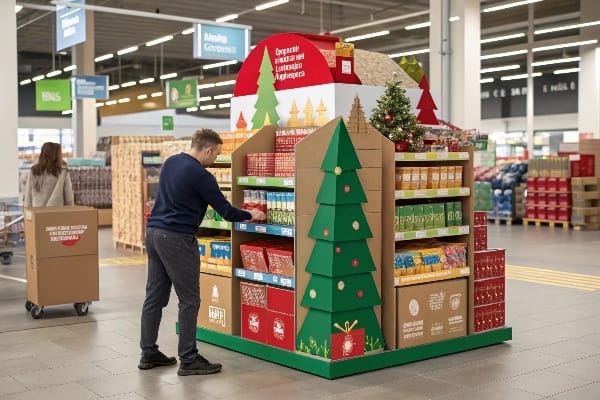
Les rôles qui permettent de faire fonctionner l'allée
Je simplifie les responsabilités. La marque définit le cahier des charges et le budget. Le distributeur approuve l'espace et les règles . Mon équipe de production transforme l'idée en une structure livrée à plat, facile à monter et résistante. Mes graphistes préparent fichiers d'impression . Mon atelier de prototypage réalise des échantillons en un à trois jours. Nous effectuons des tests de charge et de transport. Nous vérifions les couleurs sous l'éclairage du magasin. Nous imprimons en numérique pour les petits tirages et pour plus de rapidité. Nous passons à l'offset pour les grandes séries. Nous fournissons des instructions de montage simples avec des icônes. Au besoin, une agence prend en charge le design et nous nous occupons de la fabrication. Cette répartition claire des tâches évite les retouches et garantit le respect des délais de lancement.
| Rôle | Tâches principales | Quand embaucher |
|---|---|---|
| marketing commercial de marque | Note de synthèse, message, budget | Toujours |
| marchandiseur de détail7 | Espace, conformité, planogramme | Lorsque la direction est axée sur le détaillant |
| designer industriel | Structure, ligne de découpe, stabilité | Nouveaux facteurs de forme |
| Graphiste8 | Art, couleur, typographie | Chaque projet |
| Fabricant d'écrans | Prototypage, tests, production en série | De la conception au déploiement |
| Équipe de terrain / installateur | Mise en place, audit, preuve photographique | Lancement de plusieurs magasins |
| Agence (facultatif) | Concept, connaissance du consommateur | Campagnes majeures |
J'ai appris cela lors d'un lancement express pour une marque d'articles de chasse. Nous avions trois semaines pour installer de nouveaux kits d'arbalètes dans les magasins de plein air américaines . Nous avons effectué des tests tard dans la nuit, amélioré la qualité des panneaux publicitaires et verrouillé les cibles de couleur. Les présentoirs sont arrivés à temps et ont résisté à la haute saison.
Qui est impliqué dans le merchandising?
Trop de voix ralentissent le travail. Trop peu de regards exposent aux risques. Je n'invite que les personnes qui font avancer le projet. Je définis pour chacun un indicateur de réussite clair.
Les équipes chargées de la marque, du commerce de détail, du design, de la production, de la logistique et de la conformité participent toutes ; chacune est responsable d'un livrable simple : message, règles d'espacement, structure, impression, calendrier et certifications nécessaires pour réussir les audits.
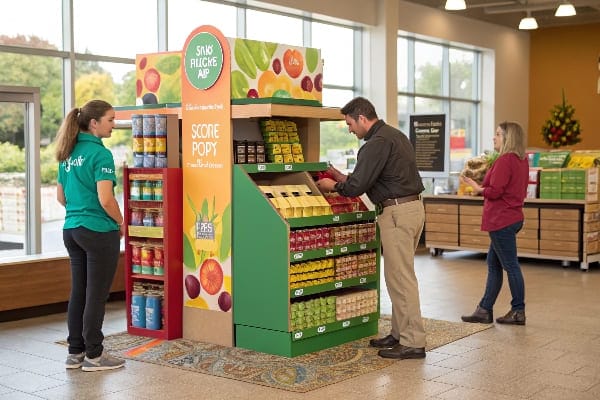
Parties prenantes et transferts de responsabilité simplifiés
Je gère les projets comme un relais. Le cahier des charges définit le client, l'offre et le budget. Le distributeur fournit les spécifications : dimensions, sécurité, étiquettes de recyclage et vitrines. Mes ingénieurs choisissent la qualité du carton et les joints. Nous privilégions le carton ondulé simple cannelure pour des raisons de coût, sauf si le poids exige du double cannelure. Nous imprimons avec des encres à base d'eau et évitons les laminations plastiques lorsqu'un vernis papier convient. Nous vérifions la certification FSC ou équivalente si nécessaire. Nous concevons des emballages plats pour réduire les frais de transport et l'empreinte carbone. Nous répartissons la production sur trois lignes pour limiter les risques. Nous emballons avec des protections d'angle et effectuons des tests de résistance aux chutes et à l'humidité. Nous préparons les codes-barres et les QR codes pour une lecture rapide. Nous expédions avec des étiquettes transparentes par magasin.
| Partie prenante | But | Ce qui les intéresse |
|---|---|---|
| propriétaire de la marque | Vendez plus, protégez votre image | Clarté du récit, retour sur investissement 13 |
| Acheteur au détail | Optimisation de l'espace | Empreinte au sol, sécurité, vitesse |
| Ingénieur produit | Ajuster et charger | Ligne de découpe, fixations, qualité |
| Plomb d'impression | Correspondance des couleurs | Pantone, éclairage, épreuve |
| Assurance qualité / conformité | Aucun problème | Certifications 14 , recyclabilité |
| Logistique | Livraison à temps | Taille de l'emballage, plan de palette |
| Magasin du magasin | Installation facile | Assemblage en 5 minutes, étapes claires |
Cette structure légère permet de maintenir les projets sereinement. Elle protège également les marges en cas de fluctuations du prix de la pâte à papier ou des droits de douane .
Pourquoi un détaillant devrait-il utiliser le marchandisage visuel?
De nombreux détaillants réduisent leurs présentoirs pour faire des économies. Les ventes stagnent alors. Les clients se désintéressent. Je considère le merchandising comme un outil de profit, et non comme un centre de coûts.
Les détaillants utilisent le merchandising visuel pour augmenter les conversions, accroître la taille du panier moyen, accélérer la découverte des produits et réduire la charge de travail du personnel ; des présentations simples sont rapidement rentabilisées grâce aux achats impulsifs et à une rotation des stocks plus rapide.
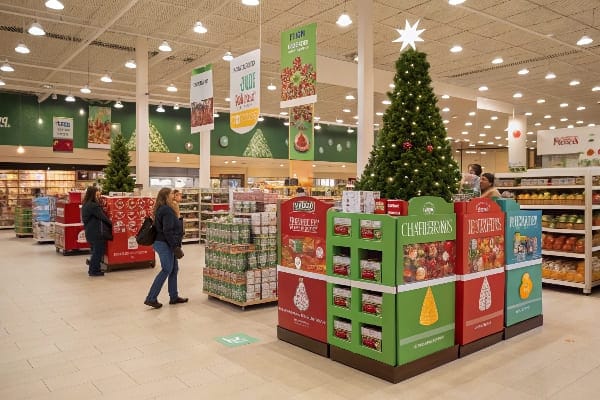
Plaidoyer pour la valeur, la rapidité et la durabilité
Je choisis le carton car il offre un bon équilibre entre coût, rapidité et impact. Il coûte moins cher que le métal ou le plastique. Il se découpe rapidement et l'impression est de qualité. L'impression numérique nous permet de tester des idées en petites séries. Nous pouvons adapter nos designs d'une semaine à l'autre. Cette rapidité est idéale pour les lancements saisonniers et les délais de vente très courts. En Amérique du Nord, la demande est stable et les règles sont claires. En Europe, les acheteurs exigent des matériaux recyclables des encres écologiques. En Asie-Pacifique, la croissance est rapide, l'agilité est donc primordiale. Les présentoirs de sol sont souvent performants car ils attirent l'attention et mettent en valeur le produit. Les présentoirs de comptoir sont efficaces en caisse. Les présentoirs sur palette sont privilégiés dans les entrepôts-magasins. J'investis dans des tests de résistance car les dommages nuisent à la confiance. J'ajoute une simple réalité augmentée ou un QR code lorsque le produit nécessite une démonstration. Je veille à ce que les affirmations soient honnêtes et concises. Après le lancement, je suis trois indicateurs clés : vente unitaire , le taux d'achats complémentaires et le temps de préparation. Lorsque ces indicateurs évoluent, les coûts de main-d'œuvre diminuent et les profits augmentent.
| Avantage | Métrique | Victoire rapide |
|---|---|---|
| Conversion plus élevée19 | Unités par magasin par semaine | Titre clair + prix élevé |
| Panier plus grand | Taux d'attachement | Vente croisée sur plateaux |
| Lancement plus rapide | Quelques jours entre la commande et la mise en magasin | sprints d'impression numérique |
| coût inférieur | Frais de transport par unité | Design plat |
| Durabilité20 | Taux de recyclage, mélange de matériaux | Carton 100% recyclable, encres à base d'eau |
Conclusion
Le merchandising visuel est efficace lorsque les équipes choisissent les bons emplacements, simplifient les rôles, utilisent des présentoirs en carton à rotation rapide et mesurent les résultats. De petits changements bien ciblés dans les allées peuvent rapidement dynamiser les ventes.
Comprendre le pouvoir d'attraction peut améliorer vos stratégies de présentation, garantissant ainsi que vos produits captent efficacement l'attention des clients. ↩
Comprendre l'importance du carton recyclable peut vous aider à vous aligner sur les pratiques de développement durable et les politiques des acheteurs. ↩
Découvrez comment un placement stratégique dans des zones à fort passage peut accroître la visibilité et les ventes. ↩
Découvrez comment l'optimisation des pages produits peut améliorer l'expérience utilisateur et augmenter les conversions. ↩
Comprendre le rôle du détaillant peut améliorer votre connaissance des stratégies efficaces de placement de produits. ↩
Explorer ce concept vous aidera à saisir l'importance d'un design de qualité dans les supports marketing. ↩
Comprendre le rôle d'un marchandiseur de détail peut améliorer votre stratégie marketing et renforcer votre conformité. ↩
Découvrir les compétences essentielles d'un graphiste peut vous aider à choisir le professionnel adapté à votre projet. ↩
Explorez ce lien pour découvrir les kits d'arbalètes les mieux notés, qui amélioreront votre expérience et vos performances de chasse. ↩
Consultez cette ressource pour trouver les principales chaînes américaines de magasins d'articles de plein air proposant une large gamme d'équipements de chasse. ↩
Explorez les avantages de l'emballage en carton ondulé simple paroi pour comprendre sa rentabilité et sa durabilité. ↩
Découvrez les avantages environnementaux et la sécurité de l'utilisation des encres à base d'eau dans les solutions d'emballage. ↩
Comprendre le retour sur investissement est essentiel pour les propriétaires de marques afin de mesurer leur succès et d'optimiser leurs stratégies. ↩
L'étude des certifications permet de s'assurer que les produits répondent aux normes de sécurité et de qualité, ce qui est essentiel pour l'assurance qualité et la conformité. ↩
Comprendre l'évolution du prix de la pâte à papier peut vous aider à prendre des décisions éclairées pour vos projets et vos investissements. ↩
L'étude de l'impact des droits de douane sur l'industrie de la pâte à papier peut fournir des informations précieuses sur la dynamique du marché et les stratégies de tarification. ↩
Explorer ce lien vous permettra de mieux comprendre les avantages environnementaux et la demande du marché pour les matériaux recyclables. ↩
Cette ressource vous aidera à comprendre les stratégies permettant d'améliorer la vitesse de production des unités, d'augmenter les ventes et l'efficacité. ↩
Explorez des stratégies efficaces pour augmenter vos taux de conversion et maximiser vos ventes au détail. ↩
Découvrez des solutions d'emballage innovantes qui améliorent la durabilité et séduisent les consommateurs soucieux de l'environnement. ↩

